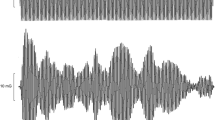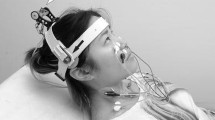Abstract
We previously showed that sinusoidal galvanic vestibular stimulation (GVS) does not modulate the firing of spontaneously active muscle spindles in relaxed human leg muscles. However, given that there is little, if any, fusimotor drive to relaxed human muscles, we tested the hypothesis that vestibular modulation of muscle spindles becomes apparent during volitional contractions at levels that engage the fusimotor system. Unitary recordings were made from 28 muscle spindle afferents via tungsten microelectrodes inserted percutaneously into the common peroneal nerve of seated awake human subjects. Twenty-one of the spindle afferents were spontaneously active at rest and each increased its firing rate during a weak static contraction; seven were silent at rest and were recruited during the contraction. Sinusoidal bipolar binaural galvanic vestibular stimulation (±2 mA, 100 cycles) was applied to the mastoid processes at 0.8 Hz. This continuous stimulation produced a sustained illusion of “rocking in a boat” or “swinging in a hammock” but no entrainment of EMG. Despite these robust vestibular illusions, none of the fusimotor-driven muscle spindles exhibited phase-locked modulation of firing during sinusoidal GVS. We conclude that this dynamic vestibular input was not sufficient to modulate the firing of fusimotor neurones recruited during a voluntary steady-state contraction, arguing against a significant role of the vestibular system in adjusting the sensitivity of muscle spindles via fusimotor neurones.





Similar content being viewed by others
References
Aimonetti JM, Hospod V, Roll JP, Ribot-Ciscar E (2007) Cutaneous afferents provide a neuronal population vector that encodes the orientation of human ankle movements. J Physiol 580:649–658
Anastasopoulos D, Mergner T (1982) Canal-neck interaction in vestibular nuclear neurons of the cat. Exp Brain Res 46:269–280
Aniss AM, Diener HC, Hore J, Burke D, Gandevia SC (1990) Behavior of human muscle receptors when reliant on proprioceptive feedback during standing. J Neurophys 64:661–670
Bent LR, Bolton PS, Macefield VG (2006) Modulation of muscle sympathetic bursts by sinusoidal galvanic vestibular stimulation in human subjects. Exp Brain Res 174:701–711
Bent LR, Bolton PS, Macefield VG (2007) Vestibular inputs do not influence the fusimotor system in relaxed muscles of the human leg. Exp Brain Res 180:97–100
Burke D, Skuse NF, Stuart DG (1979) The regularity of muscle spindle discharge in man. J Physiol 291:277–290
Burke D, Aniss AM, Gandevia SC (1987) In-parallel and in-series behavior of human muscle spindle endings. J Neurophysiol 58:417–426
Burke D, Gandevia SC, Macefield G (1988) Responses to passive movement of receptors in joint, skin and muscle of the human hand. J Physiol 402:347–361
Collins DF, Refshauge KM, Todd G, Gandevia SC (2005) Cutaneous receptors contribute to kinesthesia at the index finger, elbow, and knee. J Neurophysiol 94:1699–1706
Diete-Spiff K, Carli G, Pompeiano O (1967) Spindle response and extrafusal contraction on stimulation of the VIIIth cranial nerve or the vestibular nuclei in the cat. Pflugers Arch 293:276–280
Edin BB, Johansson N (1995) Skin strain patterns provide kinaesthetic information to the human central nervous system. J Physiol 487:243–251
Edin BB, Vallbo AB (1990a) Dynamic response of human muscle spindle afferents to stretch. J Neurophysiol 63:1279–1304
Edin BB, Vallbo AB (1990b) Classification of human muscle stretch receptor afferents: a Bayesian approach. J Neurophysiol 63:1314–1322
Fallon JB, Macefield VG (2007) Vibration sensitivity of human muscle spindles and Golgi tendon organs. Muscle Nerve 36:21–29
Fitzpatrick RC, Day BL (2004) Probing the human vestibular system with galvanic stimulation. J Appl Physiol 96:2301–2316
Fitzpatrick R, McCloskey DI (1994) Proprioceptive, visual and vestibular thresholds for the perception of sway during standing in humans. J Physiol 478:173–186
Grewal T, James C, Macefield V (2009) Frequency-dependent modulation of muscle sympathetic nerve activity by sinusoidal galvanic vestibular stimulation in human subjects. Exp Brain Res 197:379–386
Hammam E, James C, Dawood T, Macefield VG (2011) Low-frequency sinusoidal galvanic stimulation of the left and right vestibular nerves reveals two peaks of modulation in muscle sympathetic nerve activity. Exp Brain Res 213:507–514
Hammam E, Dawood T, Macefield VG (2012) Low-frequency galvanic vestibular stimulation evokes two peaks of modulation in skin sympathetic nerve activity. Exp Brain Res 219:441–446
Hulliger M, Nordh E, Thelin AE, Vallbo ÅB (1979) The responses of afferent fibres from the glabrous skin of the hand during voluntary finger movements in man. J Physiol 291:233–249
James C, Stathis A, Macefield VG (2010) Vestibular and pulse-related modulation of skin sympathetic nerve activity during sinusoidal galvanic vestibular stimulation in human subjects. Exp Brain Res 202:291–298
Kennedy PM, Cresswell AG, Chua R, Inglis JT (2004) Galvanic vestibular stimulation alters the onset of gastrocnemius motor units. Muscle Nerve 30:188–194
Lackner JR (1988) Some proprioceptive influences on the perceptual representation of body shape and orientation. Brain 111:281–297
Lackner JR, DeZio P (2005) Vestibular, proprioceptive, and haptic contributions to spatial orientation. Annu Rev Psychol 56:115–147
Lowrey CR, Strzalkowski NDJ, Bent LR (2010) Skin sensory information from the dorsum of the foot and ankle is necessary for kinesthesia at the ankle joint. Neurosci Lett 485:6–10
Lund S, Pompeiano O (1965) Descending pathway with monosynaptic action on motoneurones. Experientia 21:602–603
Macefield VG (2012) Discharge rates and discharge variability of muscle spindle afferents in human chronic spinal injury. Clin Neurophysiol 124:114–119
Mian OS, Daikin CJ, Blouin JS, Fitzpatrick RC, Day BL (2010) Lack of otolothic involvement in balance responses evoked my mastoid electrical stimulation. J Physiol 588:4441–4451
Orlovsky GN (1972) Activity of vestibulospinal neurons during locomotion. Brain Res 46:85–98
Peruch P, Borel L, Gaunet F, Thinus-Blanc G, Magnan J, Lacour M (1999) Spatial performance of unilateral vestibular defective patients in non-visual versus visual navigation. J Vestib Res 9:37–47
Pompeiano O (1972) Vestibulospinal relations: vestibular influences on gamma motoneurones and primary afferents. Prog Brain Res 37:197–232
Pompeiano O, Brodal A (1957) The origin of vestibulospinal fibres in the cat. An experimental-anatomical study. Arch Ital Biol 95:166–195
Pompeiano O, Diete-Spiff K, Carli G (1966) Two pathways transmitting vestibulospinal influences from the lateral vestibular nucleus of Deiters to extensor fusimotor neurons. Pflugers Archiv 293:272–275
Pozzo T, Levik Y, Berthoz A (1995) Head and trunk movements in the frontal plane during complex dynamic equilibrium tasks in humans. Exp Brain Res 106:327–338
Proske U, Gandevia SC (2009) The kinaesthetic senses. J Physiol 587:4139–4146
Rubin AM, Liedgren SRC, Milne AC, Young JA, Fredrickson JM (1977) Vestibular and somatosensory interaction in the cat vestibular nuclei. Pflugers Arch 371:155–160
Wall C 3rd, Oddsson LI, Patronik N, Sienko K, Kentala E (2002) Recovery trajectories of vestibulopathic subjects after perturbations during locomotion. J Vestib Res 12:239–253
Wardman DL, Fitzpatrick RC (2002) What does galvanic vestibular stimulation stimulate? Adv Exp Med Biol 508:119–128
Wilson VJ (1988) Convergence of neck and vestibular signals on spinal interneurons. Prog Brain Res 76:137–143
Wilson VJ, Kato M, Thomas RC, Peterson BW (1966) Excitation of lateral vestibular neurons by peripheral afferent fibers. J Neurophysiol 29:508–529
Acknowledgments
This study was supported by NSERC Post Doctoral Fellowship to LRB, and by the National Health and Medical Research Council of Australia (VGM). We express our gratitude to Dr. J. B. Fallon for technical and editorial contributions to this work.
Author information
Authors and Affiliations
Corresponding author
Rights and permissions
About this article
Cite this article
Bent, L.R., Sander, M., Bolton, P.S. et al. The vestibular system does not modulate fusimotor drive to muscle spindles in contracting leg muscles of seated subjects. Exp Brain Res 227, 175–183 (2013). https://doi.org/10.1007/s00221-013-3497-1
Received:
Accepted:
Published:
Issue Date:
DOI: https://doi.org/10.1007/s00221-013-3497-1




